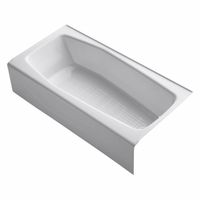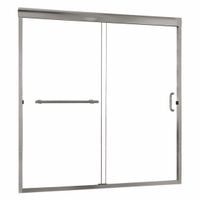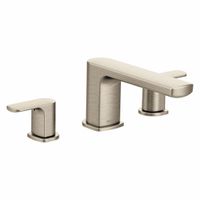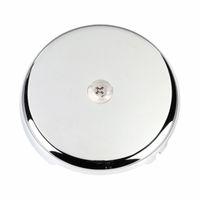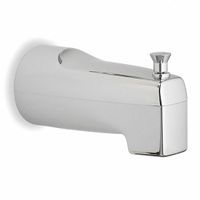Call +(254) 703 030 000 / 751 483 999 / 721 704 777
- Home
- Plumbing
- Bathtubs Showers Repair Parts
- Bathtubs
Frequently Asked Questions
What are the different types of bathtubs?
There are several types of bathtubs, each designed to cater to different needs, preferences, and bathroom layouts:
1. **Alcove Bathtubs**: These are the most common and are installed in a three-walled enclosure. They are space-efficient and often come with a showerhead.
2. **Freestanding Bathtubs**: These tubs stand alone and can be placed anywhere in the bathroom. They are available in various styles, such as clawfoot and pedestal, offering a classic or modern look.
3. **Drop-In Bathtubs**: These are installed into a pre-built deck or platform, with only the rim visible. They offer a seamless look and can be customized with different materials.
4. **Corner Bathtubs**: Designed to fit into a corner, these tubs save space and often have a triangular shape. They are ideal for bathrooms with limited space.
5. **Soaking Bathtubs**: These are deeper than standard tubs, allowing for full immersion. They are designed for relaxation and often come in freestanding or alcove styles.
6. **Whirlpool Bathtubs**: Equipped with jets, these tubs provide a massaging effect. They are ideal for hydrotherapy and relaxation.
7. **Walk-In Bathtubs**: Designed for accessibility, these tubs have a door for easy entry and exit, making them suitable for the elderly or those with mobility issues.
8. **Japanese Soaking Tubs**: Also known as "ofuro," these are deep, compact tubs designed for soaking. They are often used for relaxation and meditation.
9. **Undermount Bathtubs**: Similar to drop-in tubs, these are installed under a deck, with the rim hidden. They offer a sleek, integrated look.
10. **Air Tubs**: Similar to whirlpool tubs, but use air jets instead of water jets for a gentler massage experience.
Each type of bathtub offers unique features and benefits, catering to different aesthetic preferences and functional needs.
How do I choose the right bathtub size for my bathroom?
1. **Measure Your Space**: Start by measuring the length, width, and height of the area where you plan to install the bathtub. Consider doorways and hallways for delivery and installation.
2. **Consider Bathroom Layout**: Ensure the bathtub fits well with other fixtures like the toilet, sink, and shower. Leave enough space for movement and cleaning.
3. **Determine Usage**: Decide if the bathtub is for soaking, quick showers, or both. A deeper tub is ideal for soaking, while a standard size may suffice for showers.
4. **User Needs**: Consider who will use the tub. A larger tub may be necessary for families or taller individuals, while a smaller one might suit a guest bathroom.
5. **Standard Sizes**: Familiarize yourself with standard bathtub sizes. Alcove tubs are typically 60 inches long, while freestanding tubs can range from 55 to 72 inches.
6. **Style and Design**: Choose a style that complements your bathroom design. Freestanding tubs require more space, while corner tubs can save space.
7. **Material Considerations**: Different materials like acrylic, fiberglass, or cast iron can affect the size and weight of the tub. Ensure your floor can support the weight.
8. **Budget**: Larger and custom-sized tubs can be more expensive. Balance size with your budget constraints.
9. **Future Needs**: Consider any future changes, such as aging in place, which might require a walk-in tub.
10. **Professional Advice**: Consult with a contractor or designer for expert advice tailored to your specific bathroom layout and needs.
What materials are bathtubs made from?
Bathtubs are made from a variety of materials, each offering distinct advantages and characteristics:
1. **Acrylic**: Lightweight and versatile, acrylic bathtubs are made from vacuum-formed sheets of acrylic reinforced with fiberglass. They are popular for their affordability, ease of installation, and wide range of shapes and colors. Acrylic retains heat well, providing a warm bathing experience.
2. **Fiberglass**: Often used in budget-friendly options, fiberglass bathtubs are made from reinforced plastic. They are lightweight and easy to install but can be prone to scratching and may not be as durable as other materials.
3. **Porcelain-Enameled Steel**: These bathtubs consist of a steel base coated with a layer of porcelain enamel. They are durable, resistant to chemicals, and have a glossy finish. However, they can be heavy and may chip if struck with a hard object.
4. **Cast Iron**: Known for their durability and classic appeal, cast iron bathtubs are coated with a thick layer of enamel. They retain heat well and are resistant to scratches and dents. However, they are very heavy, requiring reinforced flooring and professional installation.
5. **Stone Resin**: Made from a blend of crushed stone and resin, these bathtubs offer a luxurious look and feel. They are durable, retain heat well, and are available in various finishes. Stone resin tubs are often more expensive and heavier than other options.
6. **Copper**: Copper bathtubs are known for their unique aesthetic and natural antibacterial properties. They are durable and develop a patina over time, adding character. Copper tubs are typically more expensive and require specific maintenance.
7. **Wood**: Less common, wooden bathtubs are crafted from treated wood, offering a natural and warm appearance. They require regular maintenance to prevent water damage and are often custom-made.
8. **Ceramic and Solid Surface**: These materials offer a high-end look with customizable shapes and finishes. They are durable and retain heat well but can be expensive and heavy.
How do I install a bathtub?
1. **Preparation**: Turn off the water supply. Remove the old bathtub if replacing. Ensure the area is clean and the subfloor is in good condition. Check that the plumbing is in the correct position for the new tub.
2. **Measure and Plan**: Measure the space to ensure the new bathtub fits. Check the drain and overflow alignment. Plan for any additional plumbing adjustments.
3. **Install the Drain and Overflow**: Attach the drain and overflow to the bathtub according to the manufacturer's instructions. Use plumber’s putty to seal the drain.
4. **Position the Bathtub**: Carefully move the bathtub into place. Ensure it is level using a spirit level. Adjust with shims if necessary.
5. **Secure the Bathtub**: Attach the bathtub to the wall studs using screws and the flange provided. Ensure it is securely fastened.
6. **Connect the Plumbing**: Connect the bathtub drain to the existing plumbing. Ensure all connections are tight and sealed to prevent leaks.
7. **Install the Surround or Tile**: If using a surround, follow the manufacturer’s instructions to install. If tiling, ensure the surface is waterproofed before applying tiles.
8. **Seal the Edges**: Use silicone caulk to seal the edges where the bathtub meets the wall and floor to prevent water seepage.
9. **Test for Leaks**: Turn on the water supply and fill the bathtub. Check all connections for leaks and make adjustments if necessary.
10. **Finish**: Install any additional fixtures like faucets and showerheads. Clean the area and remove any debris.
11. **Final Inspection**: Ensure everything is securely installed and functioning properly. Make any necessary adjustments.
What is the average cost of a bathtub?
The average cost of a bathtub can vary widely depending on several factors such as the type, material, size, and brand. Generally, the cost can range from $200 to $3,000 or more.
1. **Type**:
- **Standard Alcove Bathtubs**: These are the most common and affordable, typically ranging from $200 to $1,000.
- **Freestanding Bathtubs**: These can cost between $600 and $3,000, offering a more luxurious look.
- **Corner Bathtubs**: These are priced from $700 to $2,500, often used in larger bathrooms.
- **Drop-in Bathtubs**: These range from $600 to $2,000, requiring a custom enclosure.
- **Whirlpool and Air Tubs**: These can range from $1,000 to $3,000 or more, providing additional features like jets.
2. **Material**:
- **Acrylic**: Affordable and lightweight, costing between $300 and $1,000.
- **Fiberglass**: One of the cheapest options, ranging from $200 to $800.
- **Cast Iron**: Durable and heavy, priced between $500 and $2,000.
- **Steel**: Costs range from $300 to $1,200, offering durability.
- **Copper or Stone**: High-end materials that can cost $2,000 to $5,000 or more.
3. **Size**: Larger bathtubs generally cost more due to increased material and installation requirements.
4. **Installation**: Installation costs can add $500 to $2,000 to the total price, depending on the complexity and location.
5. **Brand**: High-end brands may charge a premium for design and quality.
Overall, the average cost of a bathtub, including installation, typically falls between $1,000 and $4,000.
How do I maintain and clean a bathtub?
To maintain and clean a bathtub, follow these steps:
1. **Regular Rinsing**: After each use, rinse the bathtub with warm water to remove soap residue and prevent buildup.
2. **Weekly Cleaning**:
- **Materials Needed**: Non-abrasive sponge, mild dish soap or a specialized bathtub cleaner, baking soda, white vinegar, and a microfiber cloth.
- **Procedure**:
- Wet the tub and sprinkle baking soda over the surface.
- Mix dish soap with warm water and use a sponge to scrub the tub, focusing on stains and soap scum.
- For tough stains, make a paste of baking soda and water, apply it to the stain, and let it sit for 15 minutes before scrubbing.
- Rinse thoroughly with warm water.
3. **Monthly Deep Cleaning**:
- **Materials Needed**: White vinegar, baking soda, and a soft brush.
- **Procedure**:
- Fill the tub with hot water and add two cups of white vinegar.
- Let it sit for 15-20 minutes, then drain.
- Sprinkle baking soda on the tub surface and scrub with a soft brush.
- Rinse thoroughly.
4. **Preventing Mold and Mildew**:
- Ensure proper ventilation by using an exhaust fan or opening a window.
- Wipe down the tub with a dry cloth after use to prevent moisture buildup.
5. **Maintaining Fixtures**:
- Clean faucets and handles with a mixture of vinegar and water to remove mineral deposits.
- Use a toothbrush for hard-to-reach areas.
6. **Avoid Harsh Chemicals**: Avoid using bleach or abrasive cleaners that can damage the tub’s surface.
7. **Regular Inspection**: Check for cracks or chips and repair them promptly to prevent further damage.
What are the benefits of a bathtub with a shower door?
A bathtub with a shower door offers several benefits:
1. **Water Containment**: Shower doors provide a more effective barrier against water splashes compared to shower curtains, reducing the risk of water damage to bathroom floors and walls.
2. **Aesthetic Appeal**: Glass shower doors can enhance the visual appeal of a bathroom, offering a sleek and modern look that can make the space feel more open and luxurious.
3. **Durability**: Shower doors, especially those made of tempered glass, are more durable and long-lasting than fabric or plastic shower curtains, which can tear or become moldy over time.
4. **Ease of Cleaning**: Glass doors are easier to clean and maintain than shower curtains. They can be wiped down with glass cleaner to remove soap scum and water spots, whereas curtains may require frequent washing or replacement.
5. **Improved Safety**: Shower doors can provide better support and stability for users entering or exiting the bathtub, reducing the risk of slips and falls. Some models also come with built-in handles or rails for added safety.
6. **Enhanced Privacy**: Frosted or textured glass options can offer privacy while still allowing light to pass through, unlike clear glass or open shower designs.
7. **Energy Efficiency**: Shower doors can help retain heat within the shower area, making for a warmer and more comfortable bathing experience, especially in colder climates.
8. **Customization Options**: Available in various styles, such as sliding, hinged, or bi-fold, shower doors can be customized to fit different bathroom layouts and personal preferences.
9. **Increased Home Value**: A well-designed bathroom with a bathtub and shower door can increase the overall value of a home, appealing to potential buyers who appreciate modern and functional bathroom features.
